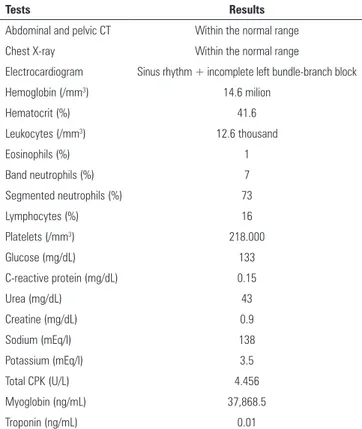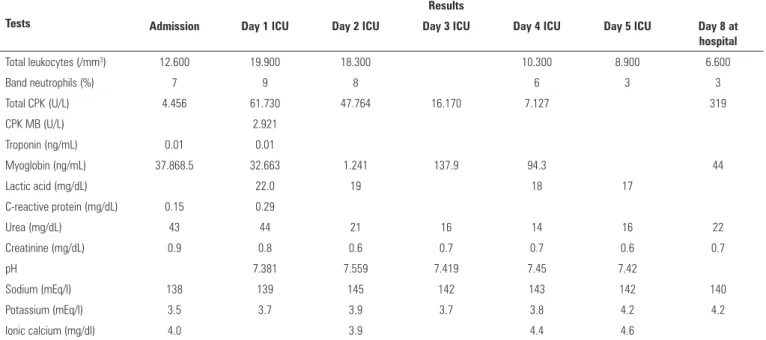Rev Bras Ter Intensiva. 2013;25(4):348-351
Haf disease associated with the ingestion
of the freshwater ish
Mylossoma duriventre
(
pacu-manteiga
)
CASE REPORT
INTRODUCTION
In the summer of 1924, physicians near the Königsberg Haf shores along the Baltic coast irst recognized an outbreak of an illness characterized by sudden, severe muscular stifness that was often accompanied by dark-colored urine.(1) No neurologic abnormalities, fever, splenomegaly, or hepatomegaly were observed.(1) he clinical spectrum of the disease varied, while most patients recovered quickly, a few patients died.
In the following 9 years, similar outbreaks afecting an estimated 1,000 individuals occurred seasonally in the summer and fall along the coast of the Königsberg lagoon. he ingestion of ish, usually cooked, was common among those who became ill, and the species of ish associated with the sickness included burbot (Lota lota), eel (Anguilla anguilla), and pike (Esox sp.). here were also reports of seabirds and cats dying after eating ish in the wild.
Due to the absence of fever and because of the fairly rapid onset of symptoms after eating cooked ish, a toxin is believed to be the cause of Haf disease.(2) Several toxic etiologies have been proposed for the disease,(3) but none have been conirmed. hey include arsenic poisoning,(3) which is still cited in modern medical dictionaries as the cause of Haf disease. he toxin does not have an unusual smell or taste, and it might be thermostable because it is not destroyed upon cooking.(4)
From 1934 to 1984, other outbreaks similar to Haf disease were described in Sweden(5) and the former Soviet Union.(6,7) he irst two cases reported in the United States occurred in Texas in June 1984. From 1984 to 1996, only four other cases were reported in the United States, two in Los Angeles and two in San Francisco (both cities in California). In 1997 ive cases of Haf disease were Oswaldo Tolesani Júnior1, Christian Nejm
Roderjan1, Edgard do Carmo Neto1, Micheli
Mikaeli Ponte1, Mariana Cristina Pelli Seabra1,
Marcos Freitas Knibel1
1. Hospital São Lucas Copacabana - Rio de Janeiro (RJ), Brazil.
Haf disease associated rhabdomyolysis is correlated with the ingestion of certain freshwater ish and shellish and is caused by an unidentiied toxin. We report the case of a patient who experienced rhabdomyolysis approximately 2 hours after ingestion of
Conflicts of interest: None.
Submitted on September 20, 2013 Accepted on December 2, 2013
Corresponding author:
Oswaldo Tolesani Júnior
Travessa Frederico Pamplona, 32 - Copacabana Zip code: 22061-080 - Rio de Janeiro (RJ), Brasil E-mail: oswaldotolesani@superig.com.br
Doença de Haff associada ao consumo de carne de Mylossoma
duriventre (pacu-manteiga)
ABSTRACT
Keywords: Rhabdomyolysis/diagnosis; Foodborne diseases; Fishes; Diagnosis, diferential; Case reports
the freshwater ish Mylossoma duriventre
(pacu-manteiga) approximately 3 years after an outbreak had been reported in Manaus, Brazilian Amazon.
Haff disease associated with the ingestion of the freshwater fish Mylossoma duriventre 349
Rev Bras Ter Intensiva. 2013;25(4):348-351
reported in the United States (in California and Missouri) during a 5-month period (March to August), all of the cases were associated with the ingestion of bufalo ish (Ictiobus sp.).(8) In 2001, more cases were reported in the United States that involved the ingestion of freshwater crayish (Cambaridae family)(9) in Missouri and salmon in North Carolina.(2) In September 2010, some cases of Haf disease that were associated with the consumption of freshwater crayish (Parastacidae family) were reported in China.(10)
In October 2008, an outbreak of 27 cases of Haf disease that were associated with the consumption of Mylossoma duriventre (pacu-manteiga), Colossoma macropomum (tambaqui) and Piaractus brachypomus (pirapitinga) ish from the Brazilian north Amazon region was reported.(11) Haf disease is considered an emerging disease, whose importance will increase as population growth leads to increasing consumption of freshwater ish, particularly in the Brazilian Amazon region.
CASE REPORT
A 48-year-old male patient who was taking inasteride for androgenic alopecia presented to the emergency room. He was returning from a 15-day trip to the city of Belém (PA) in the Northern region of Brazil. He reported that approximately 2 hours after ingesting a meal containing the ish Mylossoma duriventre, he experienced sudden, progressive, difuse and lancing abdominal pain, accompanied by two episodes of vomiting, progressive polymyalgia (predominantly in the lower limbs), asthenia and progressively disabling muscular weakness. he patient was completely lucid; he reported drinking a small amount of cofee a few seconds before the onset of symptoms, he denied experiencing fever, diarrhea, ingestion of alcohol or other medications and/or use of illicit drugs.
His vital signs were within the normal range, except for his heart rate, which was elevated (at approximately 120 bpm). On physical examination, there was difuse abdominal pain on palpation, and none of the following symptoms: pain localization, guarding, visceromegaly, palpable masses or peritoneal irritation signs.
he patient received intravenous analgesics and antispasmodic drugs, while diagnostic investigation was started. His initial laboratory tests revealed leukocytosis with neutrophilia and no elevation of C-reactive protein. Abdominal computed tomography showed no signiicant abnormality. His abdominal pain was refractory to intravenous analgesia, including opioids, a fact that stood out to the physicians on duty.
Due to persistence of the patient’s symptoms and the reported cases of Hof disease after ingestion of the ish Mylossoma duriventre in the Brazilian Northern region, his total CPK and myoglobin were measured. hey were both extremely elevated (total CPK: 4,456U/L and myoglobin 37,868.5ng/mL). A diagnosis of rhabdomyolysis was made as the ratio of total CPK/CPK-MB was greater than 5 (Table 1). he patient was hospitalized, intravenous hydration was initiated, and the analgesic treatment was intensiied.
Table 1 - Results of the ancillary tests on hospital admission
Tests Results
Abdominal and pelvic CT Within the normal range
Chest X-ray Within the normal range
Electrocardiogram Sinus rhythm + incomplete left bundle-branch block
Hemoglobin (/mm3) 14.6 milion
Hematocrit (%) 41.6
Leukocytes (/mm3) 12.6 thousand
Eosinophils (%) 1
Band neutrophils (%) 7
Segmented neutrophils (%) 73
Lymphocytes (%) 16
Platelets (/mm3) 218.000
Glucose (mg/dL) 133
C-reactive protein (mg/dL) 0.15
Urea (mg/dL) 43
Creatine (mg/dL) 0.9
Sodium (mEq/l) 138
Potassium (mEq/l) 3.5
Total CPK (U/L) 4.456
Myoglobin (ng/mL) 37,868.5
Troponin (ng/mL) 0.01
CT - computed tomography; CPK - creatine phosphokinase.
After his admission to the intensive care unit (ICU), intravenous bicarbonate was administered to promote urine alkalization and renal protection. he patient’s myoglobin (acute phase muscle injury marker) level reduced gradually, there was a sudden and transient elevation in the total CPK level followed by a gradual decrease in the level, as expected in cases of rhabdomyolysis with a benign course (Table 2).
350 Tolesani Júnior O, Roderjan CN, Carmo Neto E, Ponte MM, Seabra MCP, Knibel MF
Rev Bras Ter Intensiva. 2013;25(4):348-351
Table 2 - Muscle injury markers and major laboratory parameters during hospitalization
Tests
Results
Admission Day 1 ICU Day 2 ICU Day 3 ICU Day 4 ICU Day 5 ICU Day 8 at hospital
Total leukocytes (/mm3) 12.600 19.900 18.300 10.300 8.900 6.600
Band neutrophils (%) 7 9 8 6 3 3
Total CPK (U/L) 4.456 61.730 47.764 16.170 7.127 319
CPK MB (U/L) 2.921
Troponin (ng/mL) 0.01 0.01
Myoglobin (ng/mL) 37.868.5 32.663 1.241 137.9 94.3 44
Lactic acid (mg/dL) 22.0 19 18 17
C-reactive protein (mg/dL) 0.15 0.29
Urea (mg/dL) 43 44 21 16 14 16 22
Creatinine (mg/dL) 0.9 0.8 0.6 0.7 0.7 0.6 0.7
pH 7.381 7.559 7.419 7.45 7.42
Sodium (mEq/l) 138 139 145 142 143 142 140
Potassium (mEq/l) 3.5 3.7 3.9 3.7 3.8 4.2 4.2
Ionic calcium (mg/dl) 4.0 3.9 4.4 4.6
ICU - intensive care unit; CPK - creatine phosphokinase.
and the muscle injury markers continued to decrease. No luid and electrolyte imbalance was observed during this period.
he patient was discharged from the hospital on the 8th day after admission. He was asymptomatic, and his muscle injury markers were within the normal range.
DISCUSSION
Haf disease is an emerging disease that was irst described less than one century ago. It is characterized by symptoms of rhabdomyolysis associated with ingestion of fresh water ish.(1) A toxin is believed to be inducing the rhabdomyolysis and causing this disease,(2) but no toxin has been identiied.
Some fresh water ish species,(1-8,11) and even crawish species,(9,10) seem to be implicated in the development of Haf disease, and the disease seems to occur in outbreaks.
he irst report of an outbreak of Haf disease in Brazil was in 2009, and one of the species associated with this 2008 outbreak was Mylossoma duriventre.(11) Further studies are necessary to identify the toxin involved and what induces its expression because the species of fresh water ish and crawish in all the reports are eaten daily by many people in all the countries where outbreaks were described, without developing the disease.
In the case report, we describe an unusual presentation of Haf disease, the patient who presented to the
emergency room with an acute abdomen, suggesting that rhabdomyolysis should be considered a diferential diagnosis for the acute abdomen when an epidemiologic history and other potential explanations for the abdominal pain have been excluded.
he diagnosis of Haf disease is based on clinical suspicion, epidemiologic history (ingestion of freshwater ish in the 24 hours preceding the event), and the levels of muscle necrosis markers, particularly myoglobin and creatine kinase. It is worth emphasizing the importance of notifying the cases and obtaining samples of the meal ingested for toxin identiication. Diferential diagnosis should include other toxidromes in which rhabdomyolysis is present (e.g., arsenic, mercury, organophosphate poisoning).
Haf disease and all cases rhabdomyolysis should be treated aggressively to prevent severe metabolic and renal efects, which can lead to acute renal failure and other causes of morbidity and mortality.
CONCLUSION
Haff disease associated with the ingestion of the freshwater fish Mylossoma duriventre 351
Rev Bras Ter Intensiva. 2013;25(4):348-351
if there is an epidemiologic history (ingestion of fresh water ish or crawish 24 hours preceding the symptoms in the case of Haf disease) and when other explanations for the causes of the acute abdomen have been excluded. he toxin and all ish species associated with the development
of Haf disease are still to be identiied, but it seems that Mylossoma duriventre is one of the species associated with Haf disease in Brazil and this is the second report linking its ingestion with Haf disease.
A rabdomiólise associada à doença de Haf é correlacionada com a ingestão de certos peixes e crustáceos de água doce, sendo causada por uma toxina não identiicada. Relatamos o caso de um paciente que apresentou rabdomiólise cerca de 2 horas após
ingerir o peixe de água doce Mylossoma duriventre (pacu-manteiga) cerca de 3 anos após o relato de um surto de doença de Haf em Manaus.
RESUMO
Descritores: Rabdomiólise/diagnóstico; Doenças transmitidas
por alimentos; Peixes; Diagnóstico diferencial; Relatos de casos
REFERENCES
1. Zu Jeddeloh B. Haffkrankheit. Ergeb Inn Med Kinderheilkd. 1939;57:138-82. 2. Langley RL, Bobbitt WH 3rd. Haff disease after eating salmon. South Med
J. 2007;100(11):1147-50.
3. Lockemann G. Chemische Untersuchungen zur Haffkrankheit. Biochem Z. 1929;207:194-216.
4. Buchholz U, Mouzin E, Dickey R, Moolenaar R, Sass N, Mascola L. Haff disease: from the Baltic Sea to the U.S. shore. Emerg Infect Dis. 2000;6(2):192-5.
5. Berlin R. Haff disease in Sweden. Acta Med Scand. 1948;129(6):560-72. 6. Leshchenko PD, Khoroshilova NV, Slipchenko LM, Kaznacheĭ RIA.
[Observation of Haff-Uchs disease cases]. Vopr Pitan. 1965;24(6):73-6. Russian.
7. Strusevich AV. [Alimentary-toxic paroxymal myoglobinuria (Haff-Iuksov-Sartlan Disease)]. Arkh Patol. 1966;28(7):56-60. Russian.
8. Centers for Disease Control and Prevention (CDC). Haff disease associated with eating buffalo fish--United States, 1997. MMWR Morb Mortal Wkly Rep. 1998;47(50):1091-3.
9. Krishna N, Wood J. It looked like a myocardial infarction after eating crawfish... Ever heard of Haff disease? Louisiana Morbidity Report. 2001;12(3):1-2.
10. Zhang B, Yang G, Yu X, Mao H, Xing C, Liu J. Haff disease after eating crayfish in east China. Intern Med. 2012;51(5):487-9.

